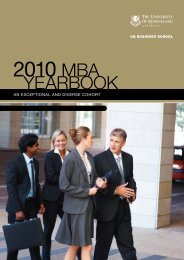Modelling the accruals process and assessing unexpected accruals*
Modelling the accruals process and assessing unexpected accruals*
Modelling the accruals process and assessing unexpected accruals*
Create successful ePaper yourself
Turn your PDF publications into a flip-book with our unique Google optimized e-Paper software.
<strong>and</strong><br />
where<br />
t a t<br />
d<br />
t<br />
m<br />
u, t PM<br />
t m t<br />
dm t d t<br />
dd<br />
u, t1<br />
<br />
PM<br />
1 t<br />
m u, t<br />
t m t<br />
dm<br />
t<br />
gm u, t1<br />
,<br />
<br />
2, t TWC TWC TWC<br />
<br />
3, t TWC TWC TWC TWC<br />
,<br />
4, t NCO<br />
<br />
5, t NCO NCO NCO<br />
u, t1 REV u, t REV<br />
3, , 3, 4, , 4, 5, , 5,<br />
<br />
<br />
t, j 0, t, j 0, t 1, t, j 1, t j 2, t, j 2, t j<br />
REV NCO NCO<br />
u, t 1 u, t 1 u, t<br />
t j t j t j t j t j t j<br />
ut ,<br />
ut ,<br />
PM represents <strong>the</strong> underlying pre-depreciation profit margin, represents <strong>the</strong><br />
economic depreciation rate, <strong>and</strong> <strong>the</strong> j subscript represents individual observation. The parameters<br />
without <strong>the</strong> j subscript ( 0,t to 5,t ) are <strong>the</strong> regression parameters, while <strong>the</strong> parameters with <strong>the</strong> j<br />
subscript ( 0, t, j to 5, t, j<br />
(12)<br />
) are <strong>the</strong> parameters of <strong>the</strong> individual observation. If this model is<br />
estimated using time-series observations of <strong>the</strong> same firm, <strong>the</strong>n <strong>the</strong> estimated parameters will<br />
reflect <strong>the</strong> time-series averaged parameters. On <strong>the</strong> o<strong>the</strong>r h<strong>and</strong>, if this model is estimated using<br />
cross-sectional observations for a given year, <strong>the</strong>n <strong>the</strong> estimated parameters will reflect <strong>the</strong> cross-<br />
sectional averaged parameters. 16 The implications of my analysis apply to both types of models,<br />
<strong>and</strong> I will refer to both of <strong>the</strong>se time-series observations <strong>and</strong> cross-sectional observations as<br />
„benchmark firms‟.<br />
The encompassing model‟s disturbance term in expression (12) for a particular firm, firm j, is<br />
often referred to as <strong>the</strong> firm j‟s <strong>unexpected</strong> <strong>accruals</strong>. It is entirely attributed to <strong>the</strong> heterogeneity<br />
in <strong>the</strong> parameters (i.e., <strong>the</strong> deviation of firm j parameters from parameters of benchmark firms).<br />
This heterogeneity is shown to be due to deviations in accounting <strong>and</strong> operating policies between<br />
16 The <strong>accruals</strong> model in Jones (1991) is originally applied in a time-series fashion. However, <strong>the</strong> cross-sectional<br />
estimation <strong>accruals</strong> model seems to be common (in Kothari, Leone, Wasley 2004 for instance). This is probably due<br />
to <strong>the</strong> superiority of <strong>the</strong> cross-section model over <strong>the</strong> time-series model (see Bartov, Gui, <strong>and</strong> Tsui 2000).<br />
24



